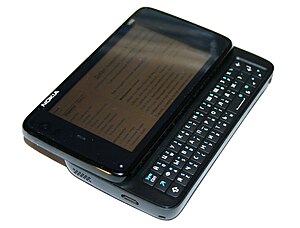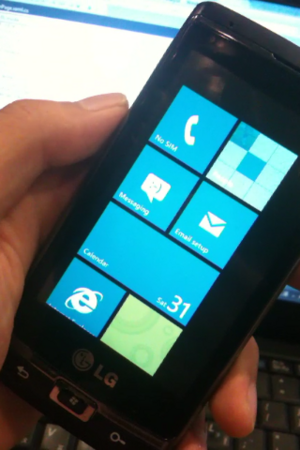 There are phones and there are tablets, and basically the only difference between them is size. But that difference is not trivial. Far from it; in mobile technology, form factor is everything. Difference in size means difference in purpose. A tablet is as big as is comfortable to use for ‘media consumption’ on the couch, a phone as small and portable as it can be while remaining usable. Anything intermediate is a compromise that falls between stools. Such is contemporary design wisdom.
There are phones and there are tablets, and basically the only difference between them is size. But that difference is not trivial. Far from it; in mobile technology, form factor is everything. Difference in size means difference in purpose. A tablet is as big as is comfortable to use for ‘media consumption’ on the couch, a phone as small and portable as it can be while remaining usable. Anything intermediate is a compromise that falls between stools. Such is contemporary design wisdom.
And it’s wrong. People use their phones more and more for browsing, reading, viewing media and playing games. All else being equal, these will always be better on a bigger screen. So it’s very arguable that the best portable device is the biggest one you can comfortably carry. How big is that though, exactly?
Bigger than you might expect. Samsung‘s view – and I tend to agree with them – is that the upper threshold is what you can easily get in and out of an ordinary jeans pocket (video). In most ways, their new Galaxy Note is just an upgraded version of their popular Galaxy S II. What sets it apart is its simply humongous 5.3″ screen, surely as big as a mobile phone can get and still remain mobile. That’s not a compromise, that’s pushing an idea to its extreme. Seen this way it’s the recent generation of 7″ Android tablets that fell between two stools – smaller than the iPad, but not small enough to be truly portable.
Some reviewers have worried about looking foolish, holding such a large device up to the face. Well yes, maybe this is not the phone for the overly self-conscious. But I suspect it will attract more glances of interest, even envy, than amusement. It’s not merely the size of the screen that makes it stand out. With its resolution of 1280 x 800 – higher than the iPad – and luxuriant saturated AMOLED colours, it’s gaining a reputation as one of the most beautiful ever seen on a mobile device.
 But the controversies only begin with the Note’s size. There’s also that pen. How can the addition of an input device somehow be a fault? For this we can blame Steve Jobs. Making a dig at the original Windows Mobile, he said “if you see a stylus, they blew it.” He was wrong too though. If you need a stylus they blew it, sure. Poking at tiny icons with a stick is not cool. But the Note has a touch interface as good as any of its rivals. More than one review has seemed almost to take offence at this. If you don’t need the pen to use the phone, what’s it doing there?
But the controversies only begin with the Note’s size. There’s also that pen. How can the addition of an input device somehow be a fault? For this we can blame Steve Jobs. Making a dig at the original Windows Mobile, he said “if you see a stylus, they blew it.” He was wrong too though. If you need a stylus they blew it, sure. Poking at tiny icons with a stick is not cool. But the Note has a touch interface as good as any of its rivals. More than one review has seemed almost to take offence at this. If you don’t need the pen to use the phone, what’s it doing there?
For sure, it would still be a fabulous device without it. You could use the Note merely as a huge-screened Web browser, HD video player and camera, e-book reader, satnav, tablet, gaming device etc. without ever withdrawing the pen from its bay. But for others – myself included – that pen is precisely the reason why we’ll be giving our money to Samsung. This is no plastic stylus. An advanced, sensitive pen would be a brilliant complement to a device big enough to use like a notebook. And once again Samsung has not cut any corners, using gold-standard technology from Wacom, makers of the Intuos and Cintiq tablets found in graphics studios worldwide. The sketching, annotation and handwriting possibilities this “S-Pen” adds put the Galaxy Note into a league of its own. Or would, if its screen hadn’t already.
It may not be on its own much longer though. It’s being joined by a rival product from fellow Koreans LG. Their Optimus Vu will have comparable dimensions and also comes equipped with a pen – rejoicing in the name “Rubberdium”. (No clues as to what the technology is yet, but they describe it as dedicated so it is probably an active device.) And it may be far from the last. The fourth iteration of Android, with its ability to scale to different screen sizes and its inbuilt support for pens, seems tailor-made for devices like this. (The Note does not actually have Ice Cream Sandwich yet, but will get it as soon as it’s ready – possibly next month.) With these features clearly part of Google’s vision, will we be seeing a phablet from Motorola next?
I hope so for the sake of diversity, but speaking for myself it’s hard to imagination any device in the near future improving on the Galaxy Note. Wacom technology appearing on a phone is a long-held dream I seriously thought would never come true. So I want to use this more than any device I’ve seen in nearly ten years. And frustratingly, about anywhere in the world seems to be getting the Note before Ireland. Vodafone has at least have confirmed they will be carrying it though. No details on pricing yet, but if you want you can register your interest here and get notified as soon as it goes on sale.
Just one question remains then – what will we call this new class of device? Phablet seems to be catching on, even if some abhor the word. Well, it’s not as bad as tabphone or phoneblet. I have a different suggestion though. We could take a word that technology has made redundant and give it a new job. Let’s call it the Phonebook.
 Apple have launched another iPad. Hooray.
Apple have launched another iPad. Hooray.










